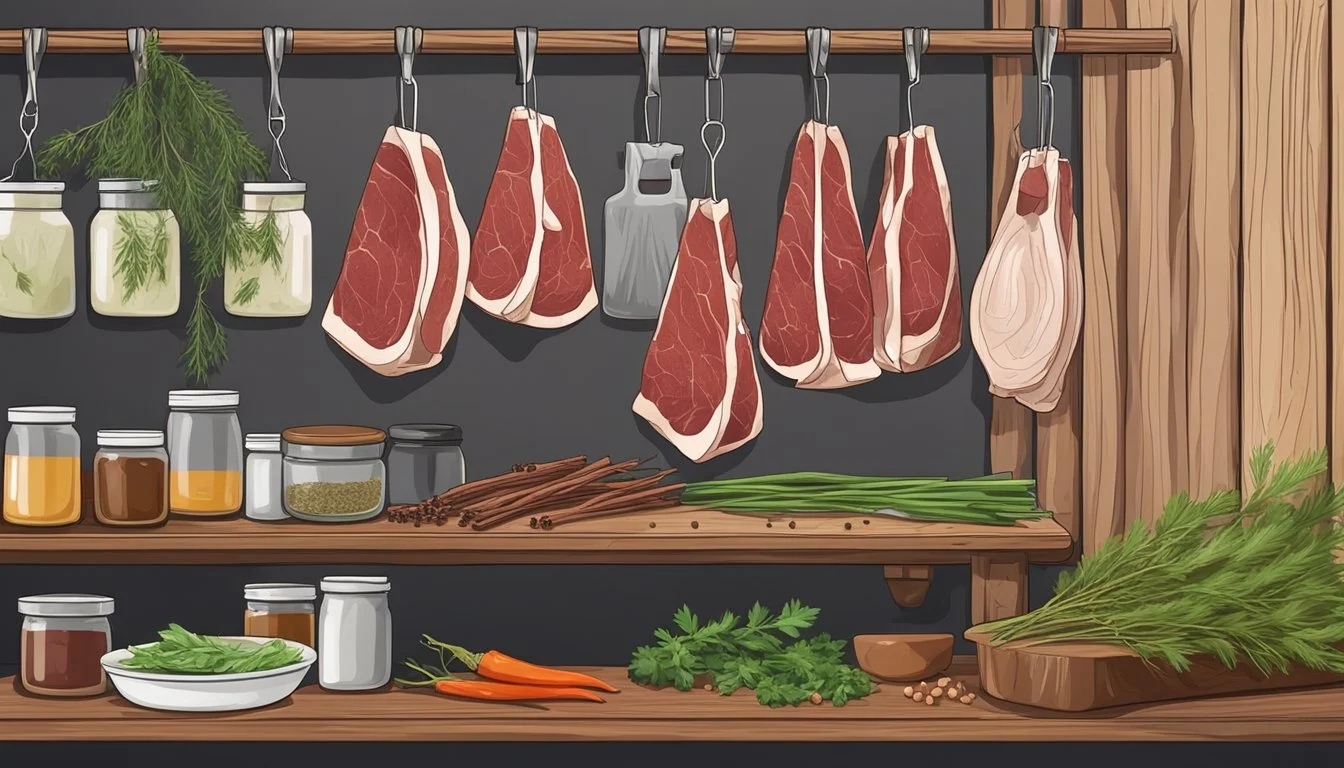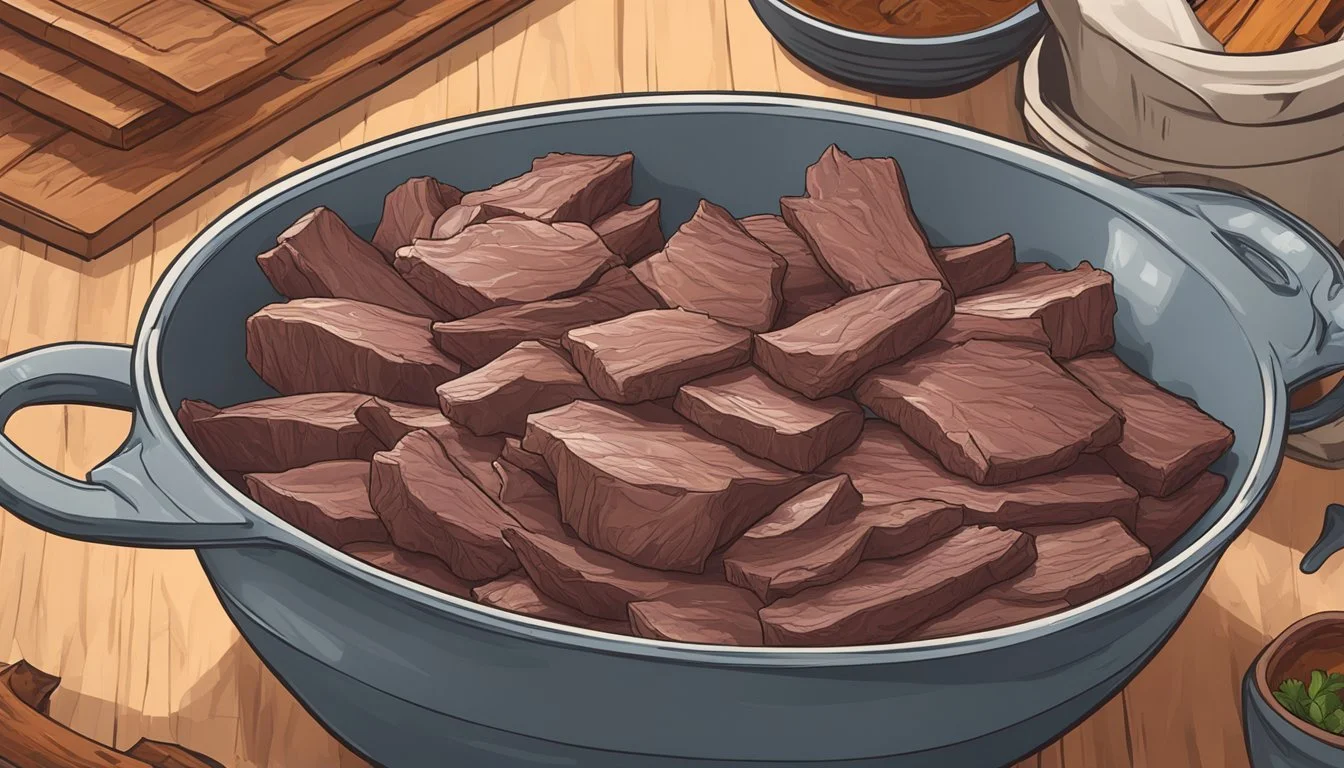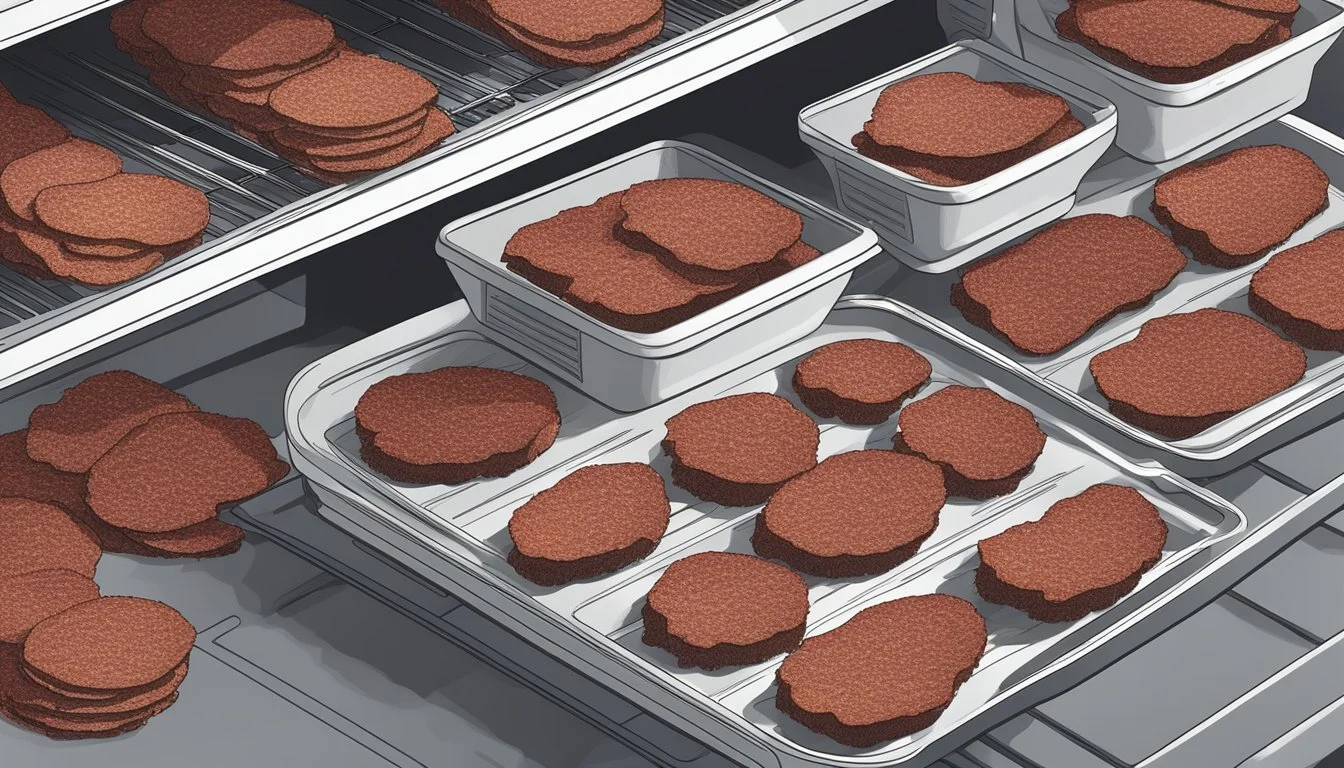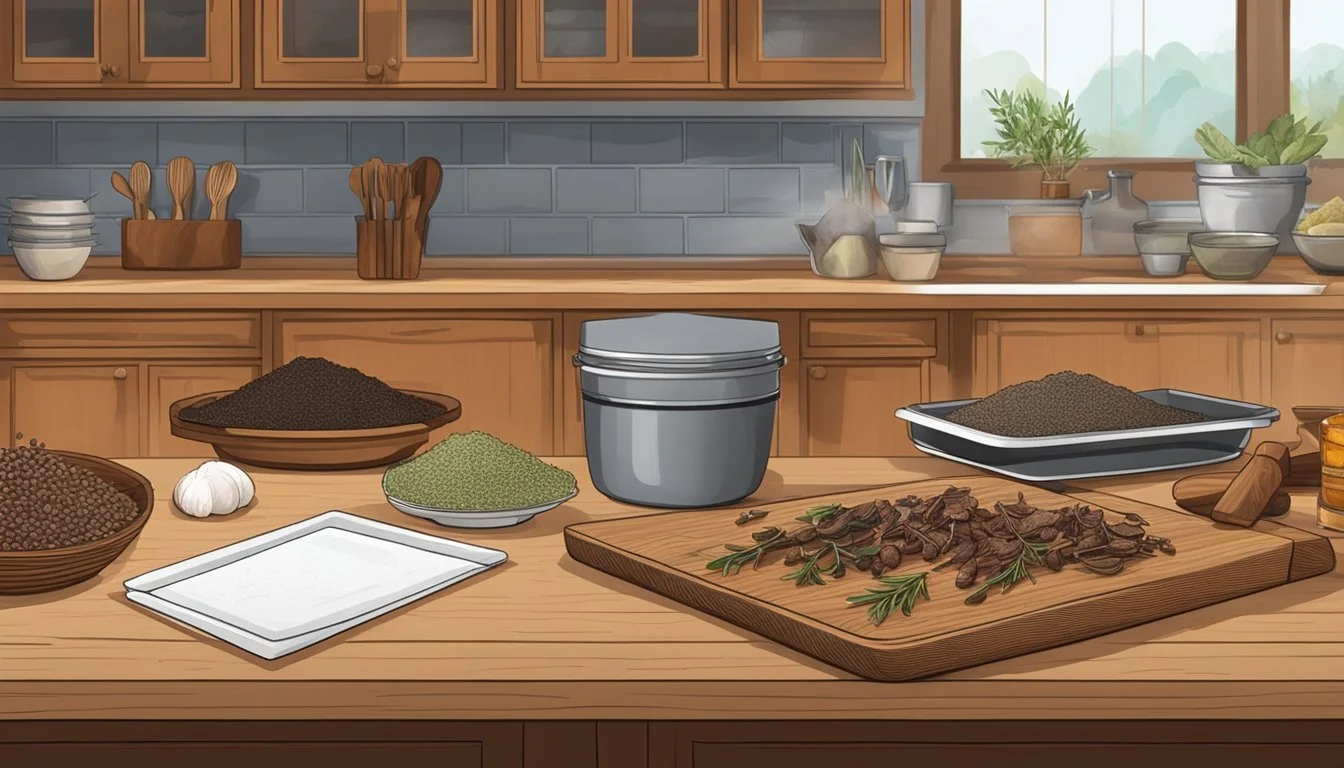Homemade Venison Jerky
A Step-by-Step Guide to Savory Snacks
Homemade venison (What wine goes well with venison?) jerky is a savory treat that meat enthusiasts can create with relative ease, using leftover deer meat. It's a practical and flavorful method to utilize an abundance of venison, transforming it into a protein-packed snack that can be enjoyed on the go or as a satisfying treat at home. The key is to marinate the thinly sliced venison and dehydrate it at a low temperature, creating a chewy and intensely flavored jerky.
The process begins with slicing the venison into consistent, thin strips, which is essential for even drying. The choice to cut the meat with or against the grain comes down to personal preference, affecting the texture and bite of the final product. A generous coating of marinade, which can contain ingredients such as Worcestershire sauce, soy sauce, or liquid smoke, infuses the meat with robust flavors.
Once the venison strips have marinated for several hours, or ideally overnight, to achieve deep flavor saturation, they are arranged on dehydrator trays or oven-safe racks, if using an oven. Drying the meat at the lowest possible setting ensures that moisture is removed slowly, culminating in jerky that's properly preserved and brimming with taste. This homemade approach allows for control over the ingredients, resulting in venison jerky that’s not only delicious but also tailored to individual flavor preferences.
Understanding Venison for Jerky
Creating homemade venison jerky starts with an understanding of the meat itself and how to properly prepare it to ensure safety and flavor. Selecting the right cut, prepping the meat appropriately, and adhering to safety measures are crucial steps in the process.
Selecting the Right Cut
When choosing venison meat for jerky, cuts such as the rump roast, leg, top round, or eye of round are ideal because they contain minimal fat and connective tissue. Before slicing, the venison roast should be partially frozen, which facilitates cutting clean, consistent thin slices. Whether to slice with or against the grain affects the texture; cutting against the grain results in a tender chew while slicing with it creates a tougher, more traditional jerky texture. Fat should be trimmed since it does not dry out and can cause the jerky to spoil faster.
Prepping the Meat
The key to easy slicing is to use a sharp knife while the venison is still partially frozen. One wants to achieve thin slices of meat, ideally between 1/8" to 1/4" thick. Removing all visible fat and silverskin from the cut of meat is important because these parts can become tough and rancid. For some, tenderizing the meat before marinating enhances the texture.
Understanding the Safety Measures
Safety when making jerky is paramount to prevent foodborne illnesses caused by bacteria or parasites. Venison should reach an internal temperature of 160°F to kill any potential pathogens. Use of curing salt can inhibit bacterial growth during the drying process. The USDA recommends heating meat to 160°F before drying or after the jerky is dried. Storing the meat in the refrigerator or freezer before and after preparation is important to reduce bacterial growth, especially if the jerky will not be consumed immediately.
Marinating the Venison
The marinating stage is crucial in making homemade venison jerky, as it is the process that infuses the meat with flavor and tenderizes it. Choosing the right combination of ingredients and understanding the marinating process will ensure a delectable batch of jerky.
Choosing Ingredients for the Marinade
When creating a marinade for venison jerky, selecting the right balance of ingredients is essential for both flavor and preservation. The base typically includes soy sauce and Worcestershire sauce, which provide a rich and umami taste, as well as salt for curing the meat. Sweet elements like sugar, brown sugar, or honey are added according to taste preference, and to create a counterbalance to the salty components.
Spices such as black pepper, garlic powder, and onion powder offer depth, while red pepper flakes introduce a hint of heat. For an authentic smoky flavor without a smoker, a dash of liquid smoke can be a game-changer. It's important to use fresh, high-quality seasonings for the best results.
The Role of Acids and Seasonings
Acidic ingredients like vinegar or citrus juices in a marinade can help in breaking down tough muscle fibers, making the venison more tender. However, with venison's naturally tender profile, acids should be used sparingly to avoid overpowering the meat's flavors or causing it to become too mushy.
The seasonings used should complement the venison's distinct taste without masking it. Kosher salt is preferred by some for its ability to draw moisture out of the meat, which is key in jerky making. Meanwhile, black pepper adds a classic pungency, and onion and garlic powders provide a savory backdrop for the other flavors to shine.
Marinating Process
To marinate the venison, slice it into consistent, thin strips to ensure even flavor penetration and dehydrating. Mix all chosen ingredients thoroughly until sugars and salts have dissolved. Immerse the venison strips completely in the marinade, ensuring each piece is well-coated.
For the marination container, a non-reactive material like glass or stainless steel is ideal, or a plastic bag can be used for ease of storage. Once the venison is in the marinade, it should be refrigerated to prevent bacterial growth. The recommended marinating time ranges between 6 to 24 hours, though many find that 12 hours strikes a perfect balance allowing the flavors to fully infiltrate the meat while maintaining its texture.
Dehydrating Venison Jerky
When creating homemade venison jerky, it's crucial to control dehydration conditions such as temperature and time to achieve the perfect texture and flavor. Methods for dehydrating venison jerky vary, but the key is ensuring consistent air circulation and careful monitoring throughout the dehydration process.
Using a Dehydrator
To dehydrate venison jerky, one should first marinate the meat and then lay the strips onto the dehydrator trays without overlapping. The optimal temperature setting for a dehydrator is usually between 150°F and 160°F. The time needed may range from 3 to 8 hours, depending on slice thickness and desired dryness. Consistent checking is advisable to prevent over-dehydration, where the jerky becomes too tough.
Dehydrator Temperature: 150°F - 160°F
Dehydration Time: 3 - 8 hours
Key Consideration: Check frequently for desired dryness.
Oven Dehydration Method
For those without a dehydrator, an oven, especially a convection oven, can be used. Preheat the oven to a low setting, around 170°F, which is usually the lowest temperature setting on many ovens. Arranging the marinated meat on a wire rack over a baking sheet will improve air circulation, mimicking a dehydrator. Oven dehydration might require 4 to 6 hours, with the door slightly ajar to ensure proper airflow.
Oven Temperature: ~170°F (lowest setting)
Dehydration Time: 4 - 6 hours
Key Consideration: Keep the oven door slightly open to enhance circulation.
Smoking the Jerky
Smoking venison jerky imparts a rich, distinct flavor, often without the need for liquid smoke flavoring. In this process, the jerky is placed in a smoker and typically smoked at a temperature between 180°F and 200°F until the desired dryness is reached. This method can take a variable amount of time and should include the use of woods like hickory or mesquite to infuse the jerky with its smoky taste. The internal temperature of the meat should reach 160°F to ensure it's fully dehydrated and safe to consume.
Smoker Temperature: 180°F - 200°F
Internal Temperature of Jerky: 160°F
Dehydration Time: Variable (check for desired dryness)
Flavoring: Smoked paprika or chipotle can be added to the marinade for extra smokiness.
Each dehydration method has its own set of principles, but the goal remains consistent: creating delicious, homemade venison jerky with the right balance of moisture and flavor.
Storage and Preservation
Proper storage technique ensures that homemade venison jerky maintains its flavor and safety. Attention to packaging and environmental factors is vital in preserving this lean and nutrient-rich meat.
Packing and Container Selection
For optimal preservation, venison jerky should be stored in an airtight container, such as a vacuum-sealed bag or a jar with a tight-fitting lid. This restricts the flow of air and prevents moisture — two factors that can deteriorate the quality of the jerky. If vacuum sealing is not an option, a zip-top plastic bag with as much air removed as possible can serve as an alternative. One must also ensure that the jerky is fully cooled before packing to prevent condensation which can lead to spoilage.
Maintaining Quality over Time
Homemade deer jerky's shelf life varies based on storage conditions. When stored in a cool and dry environment, away from heat and sunlight, it can last up to 1-2 months. If the jerky has a higher moisture content or is preferred softer, storage in the fridge can extend freshness, generally up to one week. For long-term storage, one can keep the jerky in the freezer, extending its shelf life significantly — often several months. Regardless of the method, regularly checking for any signs of spoilage is critical.
Nutritional Information
Homemade venison jerky is a nutrient-dense snack that provides a significant amount of protein. The protein content in venison is high, making it an excellent choice for fitness enthusiasts and anyone looking to increase their protein intake. Typically, a one-ounce serving of venison jerky contains about 9 to 15 grams of protein, depending on the cut and preparation method.
In addition to protein, venison is a good source of several vital nutrients. It contains B-vitamins, particularly vitamin B12, which is crucial for red blood cell formation and neurological function. Iron, zinc, and phosphorus present in venison contribute to overall nutrition, benefiting bone health and immune function.
The nutritional value of homemade venison jerky is influenced by the ingredients used in the marinade and preparation process. For those monitoring sodium intake, it's essential to consider the amount of salt used. However, homemade jerky allows for customization, enabling the reduction of additives and preservatives found in commercial products.
Here's a breakdown of key macro- and micronutrients commonly found in homemade venison jerky:
Protein: Essential for muscle repair and growth.
Iron: Important for oxygen transport in the bloodstream.
Zinc: Supports immune function and wound healing.
Phosphorus: Helps form bones and teeth.
B-vitamins: Aid in energy metabolism and various physiological processes.
Given these nutritional benefits, venison jerky stands out as a healthy homemade snack, provided it's consumed in moderation and as part of a balanced diet.
Expanding Your Jerky Repertoire
While making venison jerky may start with a simple and traditional recipe, expanding one's jerky repertoire involves experimenting with an array of flavors and exploring alternative jerky recipes. By incorporating different ingredients and techniques, one can transform this classic snack into a gourmet treat with a personal touch.
Experimenting with Flavors
Ingredients for Flavor Variation:
Original Flavor: Basic ingredients include salt, pepper, and a hint of garlic.
Teriyaki: Incorporate soy sauce, brown sugar, ginger, and garlic for a sweet and tangy profile.
Chili: Add chili powder and cayenne pepper for a spicy kick.
Smokey Flavor: A few drops of liquid smoke can impart a deep, fireside essence.
Citrus Twist: Grate orange zest into the marinade for a fresh and fruity note.
To truly customize a jerky recipe, one can mix and match these ingredients, adjusting quantities to taste. For example, combining teriyaki with a hint of chili can create a complex, layered flavor. It's important to balance the flavors so that no single ingredient overpowers the others.
Alternative Jerky Recipes
To vary the standard venison jerky recipe, one can consider the following:
Marinade Alternatives: Switch up the liquid base from soy sauce to Worcestershire sauce or balsamic vinegar for a different tang.
Sweetness Sources: Try using maple syrup or honey as sweeteners to contrast with the salty and savory aspects.
Texture Variations: For a different chew, slice the meat thicker for a more steak-like bite, or thinner for a crispier finish.
Preparation Methods: Beyond the traditional dehydrator, an oven set at its lowest temperature or a smoker can be used to dehydrate the meat. Each method infuses the jerky with a distinct texture and flavor.
When crafting an alternative homemade venison jerky recipe, one should pay attention to the drying time and temperature, as these can greatly affect the texture and safety of the jerky. Homemade venison jerky can be a delightful snack when made with attention to these details.
Conclusion
Homemade venison jerky offers a nutritious and savory way to extend the enjoyment of deer meat far beyond the hunting season. The process of making jerky allows for a wide range of flavors, from spicy to sweet, depending on one's personal taste. Individuals can choose to slice the meat with or against the grain, depending on whether they prefer a tender chew or a more traditional jerky texture.
The basic recipe for venison jerky is straightforward, involving marinating slices of deer meat and then dehydrating them in an oven, smoker, or dehydrator. Marinating time is key for flavor infusion, ranging from a few hours to overnight. When dehydrating, it's essential to maintain a low temperature, generally around 170 degrees Fahrenheit, to ensure even drying without cooking the meat.
Safety should not be overlooked; proper handling and preparation techniques are necessary to prevent spoilage and foodborne illness. Storage of the finished product is also crucial, with airtight containers helping to maintain freshness for several months.
For those seeking a DIY approach to snacking, homemade venison jerky is an excellent choice. Not only does it preserve the meat effectively, but it also allows for creativity in flavor and provides a protein-rich snack for outdoor activities or a quick energy boost.
By following tested recipes and employing patience during the dehydration process, anyone can craft delicious venison jerky right at home. This versatile treat has certainly earned its place as a favorite among home cooks and outdoor enthusiasts alike.






